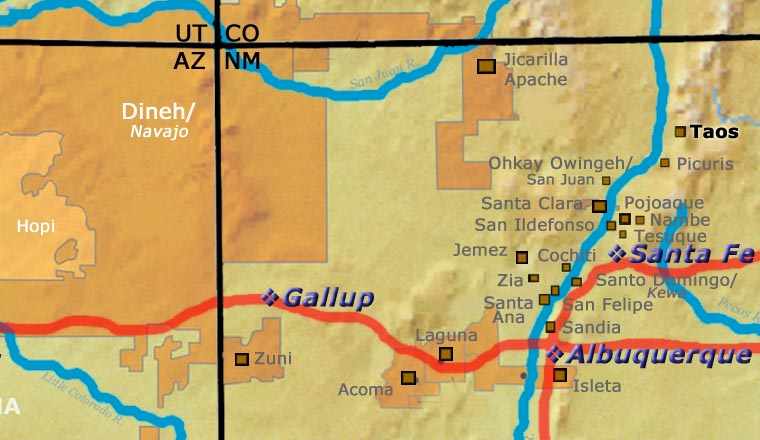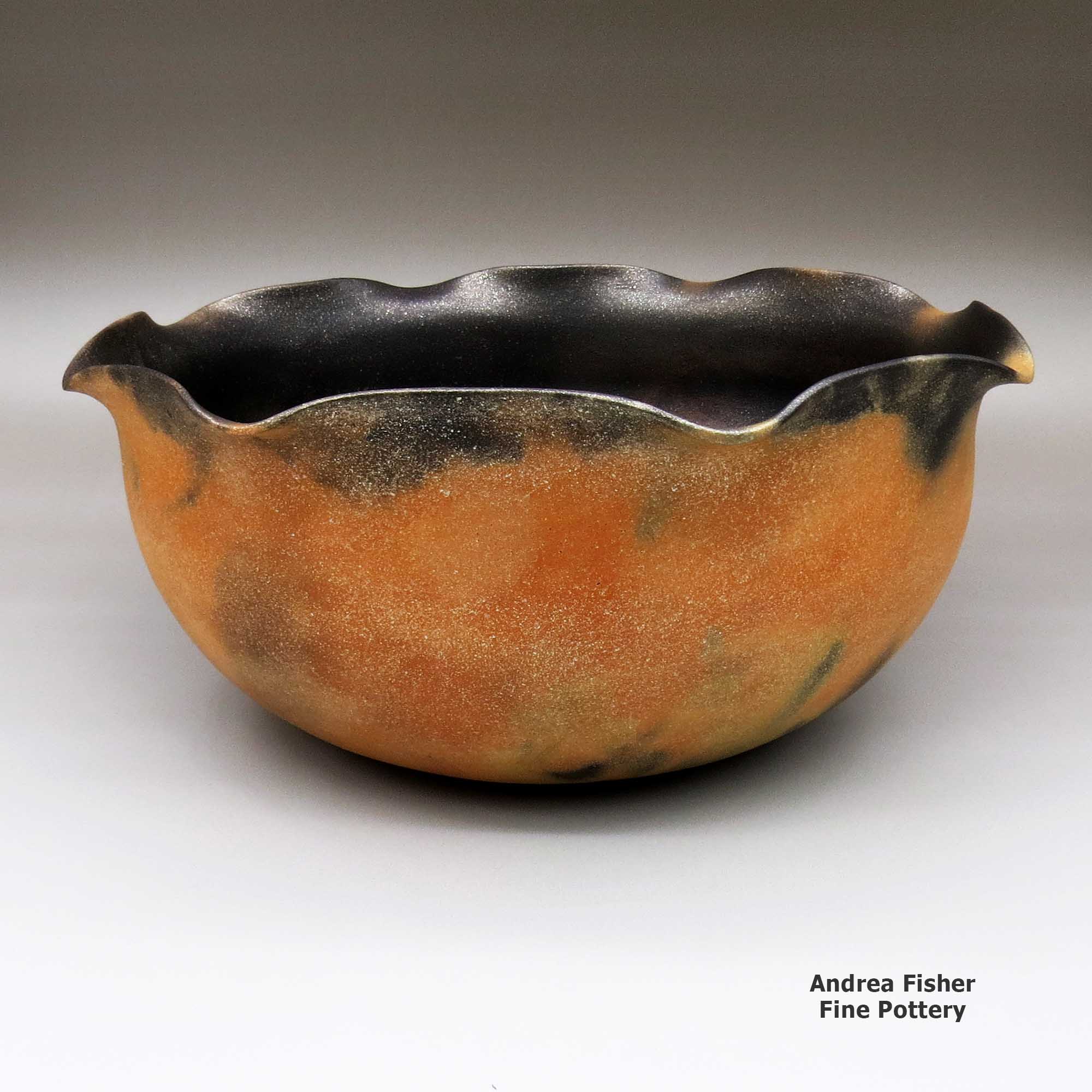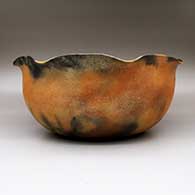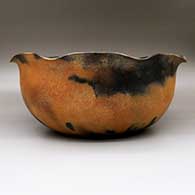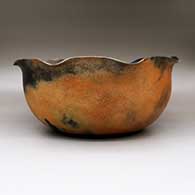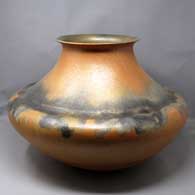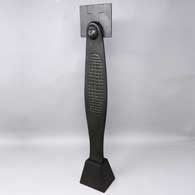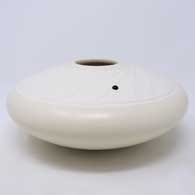
Angie Yazzie
Taos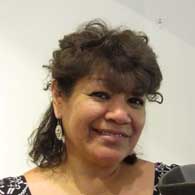
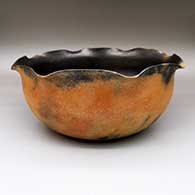
Angie Yazzie was born into Taos Pueblo in 1965. Her parents were Mary A. Archuleta of Taos Pueblo and Nick Yazzie of the Dineh (Navajo). In keeping with Pueblo tradition Angie was raised at Taos Pueblo.
Angie tells us she began making pottery when she was nine years old after being introduced to the basics by her mother and her maternal grandmother, Isabel Archuleta. Angie said she lived with her maternal grandparents for several years as a child and through them and their shop at the pueblo, she was exposed to the whole range of Pueblo arts and crafts. Clay Mother, though, is who Angie has heard calling her to work all these years.
After learning the barest basics, Angie struck out on her own and learned to make large golden and black micaceous ollas, like the ollas Taos was famous for making a hundred and more years ago. Micaceous clay has tiny flecks of mica spread throughout the clay. That mica makes it possible for a pueblo pot to hold liquids for cooking or storing. There are two seams of micaceous clay on the lands of Taos Pueblo: one golden and one black.
Angie has told us her favorite shape to make is a large, fluted water jar, slipped with micaceous clay. It is exactly that type of jar that has earned her Best of Division and First Place ribbons at the Heard Museum Guild Indian Art Fair, Best of Division and First, Second and Third Place ribbons at the SWAIA Santa Fe Indian Market and First Place ribbons at the Eight Northern Pueblos Arts and Crafts Show. Angie recently had a piece placed on display at the Winona State College Museum in Winona, Minnesota.
Angie says she still gets her inspiration from her fond memories of her maternal grandmother. At the same time, she loves to look at other artists creations and talk to them about how they made it.
Some of the Awards Angie has Won
- 2020 Heard Museum Guild Indian Fair & Market: Judge's Award - Upton Ethelbah Greyshoes, Jr. Awarded for artwork: "Give Me Water"
- 2018 Santa Fe Indian Market: Classification II - Pottery, Division A - Traditional Unpainted Pottery, Category 502 - Micaceous Ware in the style of Taos, Nambe, Picuris, any form: First Place
- 2018 Heard Museum Guild Indian Fair & Market, Classification II - Pottery, Division B - Unpainted, including ribbed, native clay, hand built, fired out-of-doors: First Place. Awarded for artwork: Black Fluted Vase
- 2018 Heard Museum Guild Indian Fair & Market, Classification II - Pottery, Division G - Pottery miniatures not to exceed three (3) inches at its greatest dimension: Honorable Mention. Awarded for artwork: Rectangle Prayer Plate
- 2017 Santa Fe Indian Market: Classification II - Pottery: Best of Classification
- 2017 Santa Fe Indian Market: Classification II - Pottery, Division A - Traditional Unpainted Pottery: Best of Division
- 2017 Santa Fe Indian Market: Classification II - Pottery, Division A - Traditional Unpainted Pottery, Category 502 - Micaceous Ware in the style of Taos, Nambe, Picuris, any form: First Place
100 West San Francisco Street, Santa Fe, New Mexico 87501
(505) 986-1234 - www.andreafisherpottery.com - All Rights Reserved

Taos Pueblo
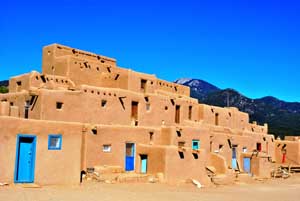
North House, Taos Pueblo
Today's Taos Pueblo consists of two main structures, both of which are counted among the oldest continuously inhabited structures in the United States. The location straddles the Rio Pueblo de Taos (also known as Red Willow Creek), whose headwaters rise in the nearby Sangre de Cristo Mountains. The pueblo was designated a National Historic Landmark in 1960 and was designated a UNESCO World Heritage Site in 1992.
The native language of Taos Pueblo is Northern Tiwa, a member of the Tanoan family of languages. It has been suggested that Northern Tiwa developed when late-arriving Tewa migrants passed across the already-overcrowded Tewa Basin around 1300 CE, and entered into the Pot Creek area to merge with the Tanoans already there.
The "precursor" pueblo to Taos was a pueblo now known as Pot Creek Pueblo. At its height, Pot Creek Pueblo might have been the largest pueblo in the Southwest. However, some kind of trouble developed at Pot Creek in the early 1300s CE, and part of the pueblo was burned with the residents scattering in different directions. Many went a few miles north to a neighboring Tanoan pueblo (Taos) and merged with them. Others went southeast, into a high pass in the mountains where they founded Picuris Pueblo.
Taos Pueblo was a center of trade long before the Spanish arrived. The pueblo served as a contact point between the Rio Grande Pueblos to the south and the Comanche, Apache and Ute to the east, north and northeast. Every fall when the annual trade fair was happening, Taos Pueblo became a neutral zone where fighting and raiding were banned for the duration of the fair. The arrival of the Spanish in 1540 didn't interfere with the trade fair cycle but after they returned in 1598, they did try to impose taxes on everyone.
Around 1620 Jesuit priests oversaw the construction of the first mission of San Geronimo de Taos. Friction between the tribe and the Spanish led to the killing of a resident priest and destruction of the church in 1660. The church was rebuilt, only to be destroyed again and two resident priests killed in the opening moments of the Pueblo Revolt of 1680. The Spanish were evicted from northern Nuevo Mexico that year but returned in force in 1692. By 1700, the third mission church at Taos was under construction.
For a few years, the tribe and the Spanish got along, forced to be amicable in order to deal with their common enemies: Ute, Apache and Comanche raiders. That pressure was relieved in 1776 when Governor Juan Bautista de Anza and his troops killed virtually the entire upper hierarchy of the Comanche tribe in the Battle of Cuerno Verde, near Greenhorn Mountain in southern Colorado.
American fur trappers and traders first appeared in the area in the early 1800s. Things changed in 1820 when Mexico declared independence and trade wagons began rolling over the Santa Fe Trail. The American military arrived in 1847, in the beginning of the Mexican-American War. That military presence quickly led to the Taos Rebellion of 1847, a rebellion which saw Governor Charles Bent and several other prominent Americans killed. A few days later American troops and armed citizens arrived from Santa Fe and, thinking the rebels had taken refuge in the mission church, they destroyed the church and killed many innocent women and children who were hiding inside it. That effectively ended the rebellion. After a short trial, 17 of the surviving rebels were hanged from trees surrounding the plaza in the nearby non-Indian village of Taos. A new mission church was constructed around 1850 near the west gate of the pueblo wall but the ruins of the old church are still visible today.
One result of the Taos Rebellion is that the tribe has never signed a peace treaty with the United States Government. That led to President Theodore Roosevelt using an Executive Proclamation to remove some 48,000 acres of the pueblo's mountain land and combine that with the fledgling Carson National Forest in 1906. That land was a point of major contention between the pueblo and Congress until it was returned to the tribe by President Richard M. Nixon in 1970. An additional 764 acres was returned to the tribe in 1996.
Today the community of Taos Pueblo is considered one of the most private, secretive and conservative of all the pueblos, even though the Pueblo of Taos offers more on-site shops for visitors than any other pueblo.
Taos potters have been making pottery for hundreds of years, much of it slipped with micaceous clay so that it could be used for cooking purposes. For many years Taos pottery was traded to the Apache, Ute, Arapaho and Comanche who came to the annual Taos trade fair, in return for buffalo meat and buffalo hides. Traditional Taos micaceous pottery is known for its glittery tan or yellow gold appearance. Generally, there was no painted decoration but there might be some form of sculpted detail. Today's Taos potters produce a variety of traditional micaceous pots.
100 West San Francisco Street, Santa Fe, New Mexico 87501
(505) 986-1234 - www.andreafisherpottery.com - All Rights Reserved

Taos
$ 4600
zzta4c010
A golden micaceous grandmother bowl with fire clouds, a pie crust rim and a blackened interior
17.25 in L by 17.25 in W by 6.75 in H
Condition: Excellent
Signature: Angie Yazzie Taos Pueblo
Date Created: 2024
100 West San Francisco Street, Santa Fe, New Mexico 87501
(505) 986-1234 - www.andreafisherpottery.com - All Rights Reserved

Micaceous Clay Pottery
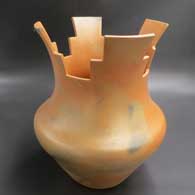
Angie Yazzie
Taos
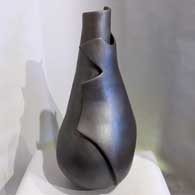
Christine McHorse
Navajo
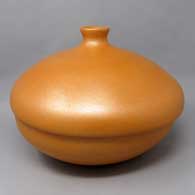
Clarence Cruz
San Juan/Ohkay Owingeh
Micaceous clay pots are the only truly functional Pueblo pottery still being made. Some special micaceous pots can be used directly on the stove or in the oven for cooking. Some are also excellent for food storage. Some people say the best beans and chili they ever tasted were cooked in a micaceous bean pot. Whether you use them for cooking or storage or as additions to your collection of fine art, micaceous clay pots are a beautiful result of centuries of Pueblo pottery making.
Between Taos and Picuris Pueblos is US Hill. Somewhere on US Hill is a mica mine that has been in use for centuries. Excavations of ancient ruins and historic homesteads across the Southwest have found utensils and cooking pots that were made of this clay hundreds of years ago.
Not long ago, though, the making of micaceous pottery was a dying art. There were a couple potters at Taos and at Picuris still making utilitarian pieces but that was it. Then Lonnie Vigil felt the call, returned to Nambe Pueblo from Washington DC and learned to make the pottery he became famous for. His success brought others into the micaceous art marketplace.
Micaceous pots have a beautiful shimmer that comes from the high mica content in the clay. Mica is a composite mineral of aluminum and/or magnesium and various silicates. The Pueblos were using large sheets of translucent mica to make windows prior to the Spaniards arriving. It was the Spanish who brought a technique for making glass. There are eight mica mining areas in northern New Mexico with 54 mines spread among them. Most micaceous clay used in the making of modern Pueblo pottery comes from several different mines near Taos Pueblo.
As we understand it, potters Robert Vigil and Clarence Cruz have said there are two basic kinds of micaceous clay that most potters use. The first kind is extremely micaceous with mica in thick sheets. While the clay and the mica it contains can be broken down to make pottery, that same clay has to be used to form the entire final product. It can be coiled and scraped but that final product will always be thicker, heavier and rougher on the surface. This is the preferred micaceous clay for making utilitarian pottery and utensils. It is essentially waterproof and conducts heat evenly.
The second kind is the preferred micaceous clay for most non-functional fine art pieces. It has less of a mica content with smaller embedded pieces of mica. It is more easily broken down by the potters and more easily made into a slip to cover a base made of other clay. Even as a slip, the mica serves to bond and strengthen everything it touches. The finished product can be thinner and have a smoother surface. As a slip, it can also be used to paint over other colors of clay for added effect. However, these micaceous pots may be a bit more water resistant than other Pueblo pottery but they are not utilitarian and will not survive utilitarian use.
While all micaceous clay from the area of Taos turns golden when fired, it can also be turned black by firing in an oxygen reduction atmosphere. Black fire clouds are also a common element on golden micaceous pottery.
Mica is a relatively common component of clay, it's just not as visible in most. Potters at Hopi, Zuni and Acoma have produced mica-flecked pottery in other colors using finely powdered mica flakes. Some potters at San Ildefonso, Santa Clara, Jemez and San Juan use micaceous slips to add sparkle to their pieces.
Potters from the Jicarilla Apache Nation collect their micaceous clay closer to home in the Jemez Mountains. The makeup of that clay is different and it fires to a less golden/orange color than does Taos clay. Some clay from the Picuris area fires less golden/orange, too. Christine McHorse, a Navajo potter who married into Taos Pueblo, uses various micaceous clays on her pieces depending on what the clay asks of her in the flow of her creating.
There is nothing in the makeup of a micaceous pot that would hinder a good sgraffito artist or light carver from doing her or his thing. There are some who have learned to successfully paint on a micaceous surface. The undecorated sparkly surface in concert with the beauty of simple shapes is a real testament to the artistry of the micaceous potter.
100 West San Francisco Street, Santa Fe, New Mexico 87501
(505) 986-1234 - www.andreafisherpottery.com - All Rights Reserved
